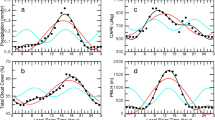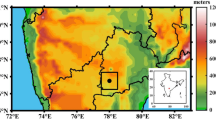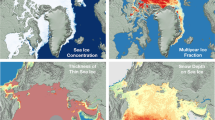Conclusions
Over the past ten years, our knowledge of the characteristics of NLC has advanced considerably, but much remains to be done before a satisfactory understanding of the nature of these clouds is obtained.
The intensive study of NLC since the I.G.Y. shows that these clouds occur over North America as frequently as in Europe and the U.S.S.R. Further, NLC displays are generally quite persistent and last for periods up to and greater than 5 hours, but individual parts (particularly the billow structure) often form and decay within a few minutes or tens of minutes. The rapid structural changes in the clouds indicate that the layer in which they are formed is well stirred and often in wave motion. In the Northern Hemisphere NLC are observed predominantly between June 1 and August 15, with the peak of activity occurring around 20 to 30 days after the summer solstice and the brightest and most widespread displays taking place between July 1 and August 15. The optimum latitude for NLC observations is around 60° N. NLC occur far more frequently than previously supposed — during the month of July, NLC are seen nearly every night in some part of the Northern Hemisphere. An observer at 60° N might expect to see NLC on about 75% of the clear nights during the month of July. Occasionally NLC displays extend over an area in excess of millions of square kilometers.
Recent studies of NLC in the Southern Hemisphere have resulted in the proof of the existence of NLC there and in the determination of some of their characteristics. Southern Hemisphere NLC were found to have a general drift motion toward the west-north-west. NLC were observed there (at 53° S) during the period December 25–January 20, with the brightest and most widespread displays occurring during the first four days of January. A comparison of these results for 53° S with those obtained from stations at 53° N suggests that NLC in the Southern Hemisphere have the same apparent frequency of occurrence with respect to the solstice as NLC in the Northern Hemisphere and that the clouds are likely to be seen at 60° S from December 1 to February 15.
Geometrical considerations of NLC observations and observational results show that the clouds are likely to be seen only during the time periods when the solar depression angle (SDA) is between 6° and 16° and that they are most easily detected at SDA from 9° to 14°. At SDA greater than 16°, the 82 km level where the NLC are formed is no longer illuminated by the sun even at the observer's horizon. An atmospheric screening height of around 30 km appears to be operative in the case of NLC.
The collection and statistical analysis of all available data on NLC provides the following picture of their characteristics in the Northern Hemisphere: Color: bluish white Height: (average) 82.7 km Latitude of Observations: 45° to 80°, best at about 60° Season for Observations: March through October, best in June through August Times for Observations: nautical and part of astronomical twilight, SDA = 6° to 16° Spatial Extent: 10 000 to more than 4000 000 km2 Duration: several minutes to more than 5 hours Average Velocity: 40 m/sec towards SW; individual bands often move in different directions and at different speeds than the display as a whole Thickness: 0.5 to 2 km Vertical Wave Amplitude: 1.5 to 3 km Average Particle Diameter: about 0.3 microns Number Density of Particles: 10−2 to 1 per cm3 Temperature in Presence of NLC: about 135° K
The available evidence suggests that the dust particles in NLC are of extraterrestrial origin and that they have a volatile coating, the nature of which is uncertain at this time although it is largely assumed to be water substance. The fact that no uncoated particles with diameters greater than 0.20 micron were found in the NLC samples obtained over Sweden in 1962 indicates that particles of this size are absent in the regions above and below the cloud layer. This result suggests that the larger particles may be formed in the NLC layer by coagulation of the smaller ones and that these particles are retained in the NLC layer by some mechanism such as large-scale vertical motions. Calculations of the fall speed of NLC particles indicate that the particles are likely to be of low density (below 1 g/cm3) and/or non-spherical in shape. In view of the large uncertainties remaining as to the nature of NLC particles and the characteristics of the region in which they form, a definitive theory explaining their formation must await further experimental data. For a satisfactory understanding of NLC more and better information is required on the following variables:
-
1)
Height, thickness, vertical wave amplitudes, horizontal wave lengths and wave speeds of NLC,
-
2)
Brightness, polarization, and spectrum of NLC,
-
3)
Wind and temperature in the NLC region both in the presence and absence of NLC,
-
4)
Water vapor concentration around the mesopause in the presence and absence of NLC,
-
5)
Concentration, composition, and shape of particles in the NLC region both in the presence and absence of clouds,
-
6)
Nature of the volatile coating on NLC particles,
-
7)
Height of the turbopause when NLC are present and absent.
The first two items can be measured from the ground, but the others will presumably require rocket measurements. A knowledge of the wind and temperature distribution would permit a decision as to whether the observed wave forms are internal gravity waves or interface waves. A knowledge of the temperature and water vapor content during the presence and absence of NLC would also be helpful in the investigation of condensation processes on NLC particles and the changes of NLC appearance. Polarization measurements at scattering angles greater than 90° would assist in determining whether NLC become visible because of an increased concentration of particles at the mesopause or because of an increase in particle size due to coating. Better information about the nature of the particles would help in making more definite theoretical deductions from ground-based optical measurements and more reliable theoretical estimates about the sinking velocities important for the theory of NLC formation. A measurement of the height of the turbopause and the turbulent state of the atmosphere in the region in question, by means of artificial vapor trails, could make an important contribution to the Chapman-Kendall theory which postulates a descent of the turbopause to the NLC region.
Because of the sometimes observed disappearance of NLC when auroral displays occur, a particularly interesting experiment would be a sequence of temperature measurements in the NLC region when aurora and NLC occur together in order to see whether a warming of the region due to auroral heating can, in fact, be discovered and whether such a warming leads to significant changes or even disappearance of the NLC by removing the coating from the nuclei or by greater turbulence which would reduce the particle concentration.
NLC are, even in the latitudes and seasons when they occur, relatively rare phenomena, but their study is related to many other problems connected with the mesopause, the lowest layer of the ionosphere, the lowest fringe of the auroral layer, and with the influx of cosmic dust. Thus their continued exploration can contribute greatly to our knowledge, not only of this particular level, but of our whole atmospheric and space environment.
Similar content being viewed by others
References
Aikin, A. C., Kane, J. A., and Troim, J., 1964: J. Geophys. Res. 69, 4621.
Alexander, W. M., McCracken, C. W., Secretan, L., and Berg, O. E., 1962: Trans. Am. Geophys. Union 43, 351.
Allen, C. W., 1946: Mon. Not. Roy. Astr. Soc. 106, 137.
Anonymous, 1962: U.S. Standard Atmosphere, U.S. Gov't Printing Office, Washington 25, D.C., 278 pp.
Arago, F., 1854: Complete works 4, 73.
Archenhold, F. S., 1928: Das Weltall 27.
Astapovich, I. S., 1939: Izvest. Akad. Nauk. SSSR, Su. Geof. i. Geogr. 2, 183.
Backhouse, T. W., 1885: Met. Mag. 20, 133.
Belton, M. J. S., 1966: Science 151, 35.
Bessonova, T. D., 1963: Research on the Climatology of Noctilucent Clouds, Article No. 6, Academy of Sciences USSR.
Blamont, J. E., and deJager, C., 1961: Annales de Géophysique 17, 134.
Burov, M. I., 1959: Transactions of Conference on Noctilucent Clouds, Estonian Academy of Sciences.
Byrne, F. D., 1964: Met. Mag. 93, 121.
Campbell, W. H., and Rees, M. H., 1961: J. Geophys. Res. 66, 41.
Chagnon, C. W., and Junge, C. E., 1961: J. of Met. 18, 946.
Chamberlain, J. W., 1961: Physics of the Aurora and Airglow, Academic Press, New York. See pp. 394–413.
Chao, J., 1965: On the Nature and Shape of Noctilucent Cloud Particles, M.S. Thesis, University of Alaska.
Chapman, S., and Cowling, T. G., 1952: The Mathematical Theory of Non-Uniform Gases, Cam- bridge Univ. Press, p. 244.
Chapman, S., and Kendall, P. C., 1965: Quart. J. Roy. Met. Soc. 91, 115.
Charlson, R. J., 1965: Quart. J. Roy. Met. Soc. 91, 517.
Craig, R. A., 1965: The Upper Atmosphere, Academic Press, New York, p. 80.
Deehr, C. S., 1961: Geophysical Institute Report No. UAG-R119, University of Alaska.
Deirmendjian, D., and Vestine, E. H., 1959: Planet. Space Sci. 1, 146.
Dole, S. H., 1962: Planet. Space Sci. 9, 541.
Dryden, H. L., Murnaghan, F. P. and Bateman, H., 1956: Hydrodynamics, Dover Publications, p. 301.
Ellyett, C. D., and Keay, C. S. L., 1964: Science 146, 1458.
Fedynski, A. V., 1966: Presented at International NLC Symposium, Tallin, Estonia, March 1966.
Fessenkov, V. G., 1949: Dok. Akad. Nauk. (SSR) 66.
Fiocco, G., and Grams, G., 1966: Tellus 18, 34.
Fiocco, G., and Smullin, L. D., 1963: Nature (London) 199, 1275.
Fogle, B., 1962: Nature (London) 199, 1080.
Fogle, B., 1964a: Geophysical Institute Report No. UAG R-159, Univ. of Alaska.
Fogle, B., 1964b: Geophysical Institute Report No. UAG R-158, Univ. of Alaska.
Fogle, B., 1964c: Nature (London) 204, 14. (See also Weather 20, 374).
Fogle, B., 1965a: Nature (London) 207, 66.
Fogle, B., 1965b: Nature (London) 207, 696.
Fogle, B., 1965c: WMO Bulletin 14, 202.
Fogle, B., 1966: Geophysical Institute Report No. UAG R-177, Univ. of Alaska.
Fogle, B., Chapman, S., and Echols, C., 1965: Geophysical Institute Report No. UAG R-162, Univ. of Alaska.
Fogle, B., and Echols, C., 1965: Geophysical Institute Report No. UAG R-163, Univ. of Alaska.
Fogle, B., and Gotaas, Y., 1963: Geophysical Institute Report No. UAG R-157, Univ. of Alaska.
Francis, R. J., Bennett, J. M., and Seedsman, D. L., 1966: Nature 211, 398.
Grishin, N. I., 1955: Meteorologiia i Gidrologiia Leningrad 1, 23.
Grishin, N. I., 1956: All Union Astr. Geod. Soc. Bull. (USSR) 19, 3.
Grishin, N. I., 1960: Some Problems of Meteorology, Article No. 1, Academy of Sciences of the USSR, Moscow.
Grishin, N. I., 1966: Paper presented at International NLC Symposium, Tallinn, Estonia, March 1966.
Gutnick, M., 1962: Air Force Surveys in Geophysics 147, Air Force Cambridge Research Labs., Bedford, Mass.
Haurwitz, B., 1964: Geophysical Institute Report No. UAG R-160, Univ. of Alaska.
Helmholtz, R., 1889: Met. Zs. 24, 186.
Hemenway, C. L., and Soberman, R. K., 1962: Astr. J. 67, 256.
Hemenway, C. L., Fullum, E. F., Skrivanek, R. A., Soberman, R. K., and Witt, G., 1964b: Tellus 16, 96.
Hemenway, C. L., Soberman, R. K., and Witt, G., 1964a: Tellus 16, 84.
Hesstvedt, E., 1961: J. Geophys. Res. 66, 1985.
Hesstvedt, E., 1962: Tellus 14, 290.
Hesstvedt, E., 1964: Geofys. Publ. 25, 1.
Hines, C. O., 1960: Canad. J. Phys. 38, 1441.
Hoffmeister, C., 1961: Ann. Int. Geophys. Year 11, 13.
Houston, R. E., 1958: J. Atmos. Terr. Phys. 12, 225.
Humphreys, W. J., 1933: Monthly Weather Review 61, 228.
Hunten, D. M., 1956: in The Airglow and the Aurorae, Pergamon Press, London, p. 183.
Ivanovsky, A. I., 1966: Paper presented at International NLC Symposium, Tallinn, Estonia, March 1966.
Jardetzky, W., 1926: Met. Zs. 61, 310.
Jesse, O., 1889: Astr. Nachr. 121, 73.
Jesse, O., 1890: Sitz.-Ber. der kgl. Preuss. Akad. der Wiss. 2, 1031.
Jesse, O., 1896: Astr. Nachr. 140, 161.
Junge, C. E., 1961: J. Meteorol. 18, 501.
Junge, C. E., Chagnon, C. W., and Manson, J. E., 1961: J. of Meteorol. 18, 81.
Junge, C. E., and Manson, S. E., 1961: J. Geophys. Res. 66, 2163.
Kaiser, T. R., 1962: Space Sci. Rev. 1, 554.
Kallman-Bijl, H., Boyd, R. L. F., Laglow, H., Poloskov, S. M., and Priester, W., 1961: CIRA, North-Holland Publi. Co., Amsterdam, 177 pp.
Kellogg, W. W. 1961: J. Met. 18, 373.
Kellogg, W. W., and Schilling, G. F., 1951: J. Met. 8, 220.
Khvostikov, I. A., 1952: Serebristye oblaka, Priroda 5 (# 5), 49.
Kiessling, J., 1888: Die Dämmerungserscheinungen im Jahre 1883 und ihre physikalische Erklärung, L. Voss, Hamburg und Leipzig.
Leovy, C. B., 1966: J. Atmosph. Sci. 23, 223.
Lettau, H., 1951: ‘Diffusion in the upper atmosphere’, in Compendium of Meteorology, American Meteorological Soc., Boston, p. 320.
Linscott, I., Hemenway, C. L., and Witt, G., 1964: Tellus 16, 110.
London, J., 1956: Transact. New York Acad. of Sci. 19, 138.
Ludlam, F., 1957: Tellus 9, 341.
Maeda, K., and Watanabe, T., 1964: J. Atmos. Sci. 21, 15.
McIntosh, B. A., and Millman, P. M., 1964: Science 146, 1457.
Meinel, A. B., Middlehurst, B., and Whitteker, E., 1963: Science 141, 1176.
Meinel, M. P., and Meinel, A. B., 1963: Science 142, 582.
Millman, P. M., and McIntosh, B. A., 1962: Geophysical Research Paper Number 75, Air Force Cambridge Research Lab., 45–52.
Millman, P. M., and McKinley, D. W. R., 1963: ‘Meteors’, in The Moon, Meteorites and Comets (ed. by B. M. Middlehurst and G. P. Kuiper), University of Chicago Press, Chicago.
Minzner, R. A., Champion, K. S. W., and Pond, H. L., 1959: Air Force Surveys in Geophysics 115, Air Force Cambridge Research Center Bedford, Mass.
Murcray, W. B., 1957: Nature (London) 180, 139.
Murgatroyd, R. J., 1957: Quart. J. R. Met. Soc. 83, 417.
Murgatroyd, R. J., and Singleton, F., 1961: Quart. J. R. Met. Soc. 87, 125.
Newkirk, G., and Eddy, J. A., 1964: J. Atmos. Sci. 21, 35.
Nordberg, W., 1966: Personal communication.
Nordberg, W., and Stroud, W. G., 1961: NASA Technical Note D-703.
Nordberg, W., Katchen, L., Theon, J., and Smith, W. S., 1965: NASA publication No. X-651-65-154, Greenbelt, Maryland.
Pant, P. S., 1956: J. Geophys. Res. 61, 459.
Parthasarathy, R., 1966: Private communication.
Parthasarathy, R., and Rai, D. B., 1966: Radio Science (in publication).
Paton, J., 1949: Met. Mag. 78, 354.
Paton, J., 1951: Met. Mag. 80, 145.
Paton, J., 1964: Met. Mag. 93, 161.
Paton, J., 1965a: Met. Mag. 94, 180.
Paton, J., 1965b, Personal communication.
Ratcliffe, J. A., and Weeks, K., 1960: Physics of the Upper Atmosphere (edited by J. A. Ratcliffe), Academic Press, New York. (See p. 379).
Rosinski, J., and Pierrard, J. M., 1964: J. Atmos. Terr. Phys. 26, 51.
Schilling, G. F., 1964: Journ. Geoph. Res. 69, 3663.
Schilling, G. F., 1965: Journ. Atm. Sci. 22, 110.
Schröder, W., 1965: Gerl. Beitr. Geophys. 74, 471.
Schröder, W., 1966: Meteorolog. Rundschau 19, 26.
Scultetus, H. R., 1949: Z. für Met. 3, 272.
Sharanov, V. V., 1960: Izdat. Leningradskago Universiteta 1, 66, Leningrad University Press.
Sharonov, V. V., 1965: Meteorologicheskiye Issledovaniya, 9, 143, Izdatel'stvo “Nauka”, Moscow.
Shefov, N. N., 1966: Paper presented at International NLC Symposium in Tallinn, Estonia, March 1966.
Skrivanek, R. A., and Soberman, R. K., 1964: Tellus 16, 114.
Soberman, R. K., 1966: Paper presented at International NLC Symposium, Tallinn, Estonia, March 1966.
Soberman, R. K., Chrest, S. A., Manning, J. J., Rey, L., Ryan, T. G., Skrivanek, R. A., and Wilhelm, N., 1964: Tellus 16, 89.
Störmer, C., 1933: Oslo University Publication 6.
Störmer, C., 1935: Astrophysica Norvegica 1, 87.
Stroud, W. G., Nordberg, W., Bandeen, W. R., Bartman, F. L., and Titus, P., 1960: J. Geophys. Res. 65, 2307.
Theon, J. S., Nordberg, W., and Katchen, L. B., 1966: Paper presented at American Meteorological Society Meeting in Seattle, Washington, June 1966.
Trubnikov, B. N., and Skuratova, I. S., 1966: Paper presented at International NLC Symposium, Tallin, Estonia, March 1966.
VandeHulst, H. C., 1947: Astrophys. J. 105, 471.
VandeHulst, H. C., 1957: Light Scattering by Small Particles, John Wiley & Sons, New York, pp. 114–128.
Vassilyev, O., 1962: Trans. Conference on Noctilucent Clouds, Tallin, p. 68.
Vegard, L., 1933: Geofys. Pub. 10, 53.
Vestine, E. H., 1934: Journ. Roy. Astron. Soc. Can. 28, 249, 303.
Villmann, Ch., 1962: Trans. Conference on Noctilucent Clouds, Tallin, p. 29.
Villmann, Ch., 1966: Presented at International NLC Symposium, Tallinn, Estonia, March 1966.
Volz, F. E., 1966: Personal communication.
Volz, F. E., and Goody, R. M., 1962: J. Atmos. Sci. 19, 385.
Webb, W., 1965: J. Geophys. Res. 70, 4463.
Wegener, A., 1926: Met. Zs. 61, 103.
Whipple, F. J. W., 1930: Quart. J. Roy. Met. Soc. 56, 287.
Whipple, F. L., 1954: Astr. J. 59, 201.
Whipple, F. L., 1961: Nature (London) 189, 127.
Whipple, F. L., and Hawkins, G. S., 1956: J. of Met. 13, 236.
Witt, G., 1957: Tellus 9, 365.
Witt, G., 1960a: J. Geophys. Res. 65, 925.
Witt, G., 1960b: J. Geophys. Res. 65, 2199.
Witt, G., 1962: Tellus 14, 1.
Witt, G., Hemenway, C. L., Lange, N., Modin, S., and Soberman, R. K., 1964: Tellus 16, 103.
Witt, G., Martin-Löf, J., Wilhelm, N., and Smith, W. S., 1965: in Space Res. (ed. by D. G. King-Hele, P. Muller, and G. Rigini), vol. V, p. 820.
Zhukova, L. P., and Trubnikov, B. M., 1966: Paper presented at International NLC Symposium, Tallinn, Estonia, March 1966.
Author information
Authors and Affiliations
Additional information
Also affiliated with the University of Texas as University Professor.
Rights and permissions
About this article
Cite this article
Fogle, B., Haurwitz, B. Noctilucent clouds. Space Sci Rev 6, 279–340 (1966). https://doi.org/10.1007/BF00173768
Received:
Issue Date:
DOI: https://doi.org/10.1007/BF00173768




